In school, we learn that there are 7 Ps in the marketing mix: product, place, people, process, physical evidence, promotion, and price.

Traditionally, each of these P’s has been an important way to differentiate your company from the competition. Whether it was the quality of your product or the location of your store, these P’s served as sign posts telling your customers why they should buy from you.
But do each of these P’s still hold up in the 21st century? The short answer is yes, but the importance of each is changing.
Today’s retail market differs vastly from the 1990s and the 2000s, and the internet has fundamentally changed the retail sector. Consumers now have the power to comparison shop instantly. The rise of online shopping also eliminates the need for physical stores and opens up competition to the entire internet, not just the physical locations nearby.
These changes have a huge impact on the way shops should manage their marketing — and which P’s they should pay attention to in the marketing mix. As the internet has levelled the online playing field, one P has emerged as the clear focus for most consumers: Price.
In fact, price is so important, McKinsey found that just a 1% improvement in pricing raises profits by 6%.
That's more influential than a 1.0% reduction in variable costs (which increased profits by 3.8%) or a 1% reduction in fixed costs (which yielded a 1.1% increase in profits).
In this blog post, I’ll explain how price became the most important factor in the marketing mix, and how shops can use pricing data to increase their marketing ROI.
Click here to download your free copy of Why Pricing and Marketing Go Hand-in-Hand
The 7 P’s in Marketing
Let’s look at the relevance of the 7 P’s in today’s online marketing context:
- Product is less of a differentiator to consumers as shops broaden their assortment and more shops offer the same products
- Place is less of a differentiator as consumers order from their computer or phone
- People are less of a differentiator as there is no interaction with people online
- Process is less of a differentiator as most shops offer 24 hour home delivery
- Physical evidence, or store quality, is less of a differentiator as the web shop becomes the most important “store.” The quality of the web shop is equally important, but it is easier to maintain
- Promotion, or online marketing itself, is more important as the number of marketing channels has increased
- Price is a bigger differentiator as prices are transparent and easily comparable
As you can see, the internet has made all but two of the 7 P’s less important: Pricing and Promotion. How a person finds your product online, and how much the displayed price is, are the most crucial checkpoints for shops to make a sale online.
Considering this, it might seem like Pricing and Promotion share equal importance in the marketing mix. But the reality is that Pricing stands far above Promotion because Pricing controls Promotion. In fact, pricing is the single most important factor to consider while managing your online marketing product ads on platforms like Google Shopping.
Talk to one of our consultants about dynamic pricing.

How pricing and marketing work together
To show how important pricing is to marketing, let‘s look at a real-life example of the relationship between the two.
In the graph below, you can see two metrics over the course of two months: a shop’s pricing and the number of units sold. The line graphs represent the price and the bar chart at the bottom shows the number of units sold.
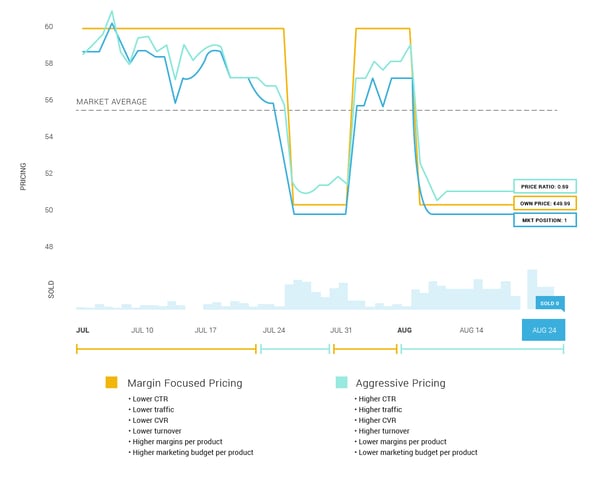
As you can see, this store applies two different pricing strategies in this period:
-
A margin-focused strategy from the beginning of July to the 24th, where the shop is priced higher than the market average.
-
An aggressive strategy from the beginning of August until the end of the data where the shop is priced lower than its competition.
Looking at the number of units sold during this period, it’s obvious the aggressive pricing strategy resulted in more sales. All other conditions staying the same, the simple change in price led to a dramatic change in sales.
It’s important to note that more sales do not necessarily lead to more bottom-line margin. Although there might be a high volume of sales, the prices (and margins, as a result) might be lower. But you can use this information strategically to decrease prices on select items and draw traffic to your website.
How pricing affects marketing
Now that we’ve shown the importance of pricing in today’s marketing mix, let’s dive deeper and examine their interactions.
There are two ways pricing influences marketing performance: budget and efficiency. The following graphic illustrates the relationship between the two silos:
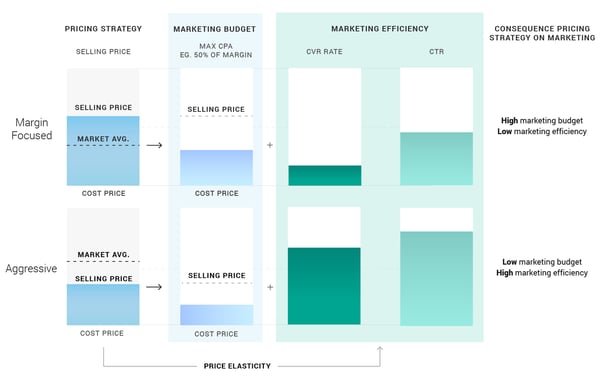
In this illustration you can see two things:
1. Pricing strategy determines the marketing budget
The price of a product online determines how much margin that product will make, a portion of which can be used for marketing. If the product has high margins, marketers have more money to market a product. However, if a product has lower margins, there is less money for a marketing strategy, the right pricing and marketing tools.
2. Pricing strategy affects the marketing effectiveness
When you are priced lower than your competitors, the chance customers will click on your ad and buy your product increases. These higher click-through rates (CTR) and conversion rates are signs of healthy, effective marketing campaigns.
So if a higher price creates a bigger marketing budget, but a lower price increases the effectiveness of your campaigns, there is a clear challenge. How do you find the right price that it optimal for both your marketing budget and efficiency?
This question gets more complicated when you consider that this balance is different for every single product on the market. That’s because consumers value items differently and respond accordingly to price changes.
This is called the price elasticity, and it is a phenomenon that shops need to consider in their pricing strategies to optimize margins. For example, an increased price for a popular TV will most likely lead to a significant decrease in CTR and conversion rate but an increased price for a TV wall mount (often sold along with the TV) may have negligible effects on click through and conversion rates. You can use this information to pair items together strategically and maximize profits.
As a result, you will need to adjust your marketing bids with each price change. Each time you — or one of your competitors — changes the selling price of a product, the CTR and conversion rate will also change for that specific product. But doing this manually is nearly impossible, which is why you need to find an integrated way of managing pricing and marketing.
Marketing vs Promotion
There’s no way to properly plan how to market a product without eventually discussing promotion. Preliminary research helps bring a product to a new market, yet the process necessitates subsequent implementation.
Discussing and planning promotion helps further define a marketing plan and marketing mix strategy. Customising marketing mix elements creates a unique marketing model for each product.
What is the Marketing Mix?
The marketing mix consists of a number of factors under the control of a brand that influences customers to buy products. Some use the term, “marketing mix” interchangeably with the P’s of marketing. The P’s have evolved over the years, growing in number.
The 7 P’s of marketing builds upon the traditional 4 P’s of marketing, product, place, price, and promotion. Let’s further explore “place” in context as to provide a 4 P’s of marketing example.
Twitter is a popular social media platform. And, though it’s not a physical place, it serves as an example of a place to study, find, and build rapport with customers.
Identifying places where a brand focuses energy and resources is among the elements of a marketing plan. For, it may be more successful and profitable for one brand to focus energies on Twitter while a competitor uses another platform or decides to neglect social media altogether to meet its marketing goals.
Marketing mix variables should be defined per product; a strategy for selling smartphones is independent from one associated with canned fruit. However, methods, marketing channels, and messages may overlap.
Similarly, a retail mix should differ from a marketing plan for wholesale goods. A product mix analysis helps differentiate and customise individual marketing plans for each product. Some companies refer to sales history while others analyse the performance of competitors before developing a marketing plan and promotional strategies.
3 methods of pricing and marketing integration
So, now that we’ve established the impact of pricing on marketing, let’s discuss how to take advantage of this phenomenon.
Typically, shops use one of the following three methods of integrating their pricing and marketing information:
1. No access to pricing data for marketing management:
Although pricing is the #1 factor impacting online marketing results, it is still rarely used as input for marketing management. Without pricing context, it’s hard to evaluate the performance of online marketing campaigns.
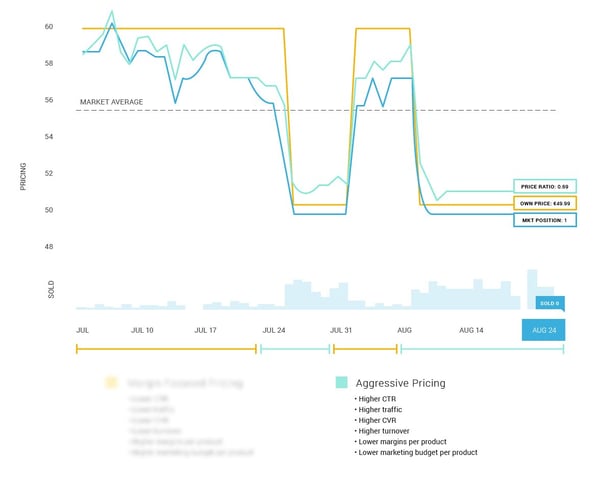
Let’s take another look at the earlier graph of historical pricing data. The online marketing department will probably be satisfied with the performance in the periods of aggressive pricing strategy, but wonder why conversion rates dropped during the margin-focused periods.
If they had access to pricing data, they’d be able to understand why these changes occurred: during the aggressive pricing periods, there were more clicks on the product because the price was low, but during the margin-focused periods the online marketing was less effective because of a higher price. They‘d be able to use that input in future marketing campaigns and prevent wasted ad spend on out-priced products.
2. Pricing information as fixed input for marketing:
If you manage your pricing and marketing strategies separately, you can still use the pricing data as fixed input for the marketing department. In the above examples of margin-focused and aggressive pricing strategies, the historical data shows how this product reacts to price changes.
With this information, the marketing team can change bids to match new price levels, which will increase your ROIs. For example, if the price ratio (which is your price vs. your competitor’s prices) changes, the marketing team can proactively change bids marketing to match the expected performance at the new pricing level.
But this strategy isn’t foolproof. Marketing can only work with the pricing information they’re provided, a data set which requires a significant amount of work to find.
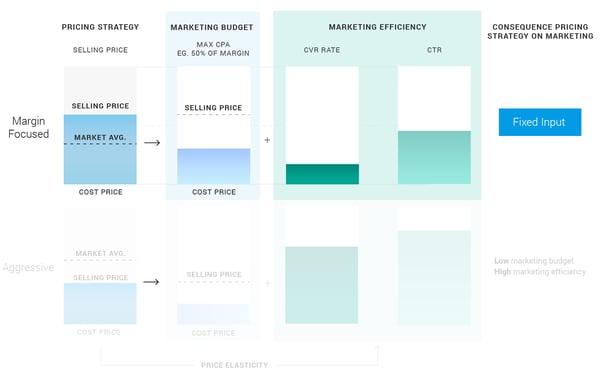
3. Integrated management of dynamic pricing & marketing.
When you fully integrate your marketing with Dynamic Pricing, the data becomes powerful. At this point pricing is not just a fixed input for marketing. Instead, the selling price itself is also adjustable.
With this dynamic input, you can find the perfect balance between pricing, marketing budget, and marketing efficiency. This ensures marketing is effective, but also creates enough margin to ensure a healthy marketing budget.
So, is this the full answer to pricing and marketing integration?
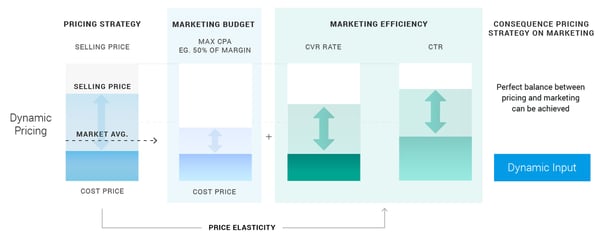
Unfortunately, it isn’t. The above example is a simplified situation, and it doesn’t fully cover all the intricacies of the relationship between pricing and marketing. To uncover that answer, we need to go one level deeper. It will get a little murky at first, but all becomes clear soon.
The full interaction between pricing and marketing performance
The combination of your marketing budget per product (the CPA) and the marketing effectiveness predict which CPC bid is still profitable to sell a single product.
However, it does not yet predict the amount of traffic you expect to generate for a specific product over a given period. Without that traffic information, you can’t predict the overall bottom-line results your marketing campaigns will generate. In terms of overall turnover and profit of the online campaign, you are still in the dark.
Adding traffic information illuminates this information and gives you a better decision-making framework to use.
Below, we've added 3 different traffic KPIs to the model:
-
Cost-per-click (CPC): the amount you are willing to pay for one click. The higher the CPC, the higher the chance is that Google Shopping (for example) will display your ad
-
Impressions: the number of times your ads are displayed
-
Clicks: the number of times a customer clicks on the ad and visits your website
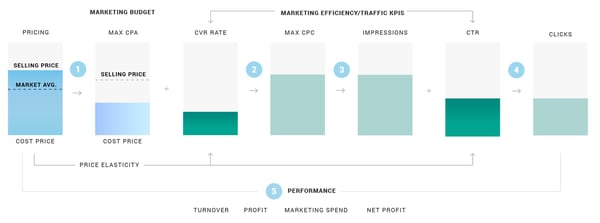
Now that this information is available, let’s go through it from the left to right in five steps and examine the interactions:
-
The pricing level determines the maximum marketing budget per product (max CPA) and predicts the conversion rate of that product at that specific pricing level
-
The combined conversion rate and maximum CPA roughly determine the maximum profitable CPC. If you have a CPA of €10 and a conversion rate of 5%, you are willing to pay up to €0,50 per click (a max CPC of €0,50)
-
The maximum CPC determines how many impressions you can buy
-
The impressions and the click-through rate determine how many clicks you can generate. It’s important to remember that the display price also affects the CTR.
-
The clicks, together with the conversion rate and pricing level, lead to the overall bottom-line performance.
Finding the right balance between all these parameters is an enormous challenge.
Conclusion
When you integrate your pricing data with your online marketing strategy, you can find the perfect balance between price, marketing budget, and marketing efficiency.
The pricing insights, combined with a number of other KPIs and metrics give marketers the information they need to make smarter marketing choices and bids. That‘s why, out of all the 7 P’s, pricing has the largest impact on online marketing.
But many online marketing management teams still don’t recognize the power of pricing data or use it to its full potential. And for those who do recognize the possibilities, there isn’t an easy way to execute the strategy manually.
Read more about interesting pricing strategies here:
- What is Dynamic Pricing?: The ultimate guide to dynamic pricing.
- What our the best pricing strategies?: Read about 17 pricing strategies for you as a retailer or brand.
- What is Price Monitoring?: Check out everything you need to know about price comparison and price monitoring.
- What is Value Based Pricing?: A full overview of how price and consumer perception work together.
- What is Charm Pricing?: A short introduction to a fun pricing method.
- What is Penetration Pricing?: A guide on how to get noticed when first entering a new market.
- What is Bundle Pricing?: Learn more about the benefits of a bundle pricing strategy.
- What is Cost Plus Pricing?: In this article, we’ll cover cost-plus pricing and show you when it makes sense to use this strategy.
- What is Price Skimming?: Learn how price skimming can help you facilitate a higher return on early investments.
- What is Map Pricing?: Find out why MAP pricing is so important to many retailers.




